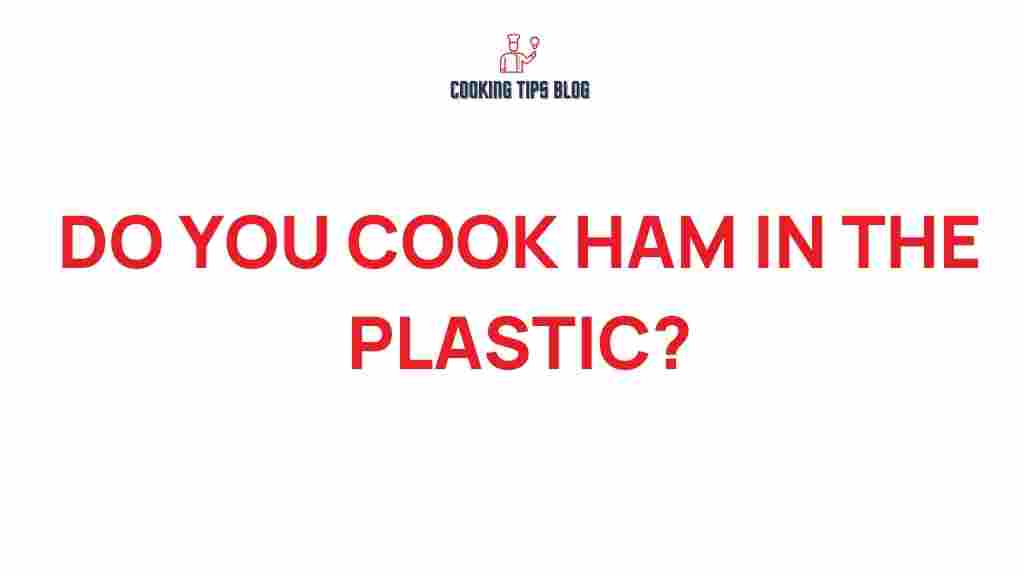Cooking Ham: The Surprising Truth About Using Plastic
Cooking ham is a beloved tradition in many households, especially during holidays and special occasions. However, one question that often arises is whether it’s safe to cook ham in plastic. This article will explore the surprising truth behind this practice, examining safety concerns, cooking methods, and tips for achieving the perfect ham. By the end of this article, you’ll have a comprehensive understanding of whether you should cook ham in plastic and how to do it safely if you choose to.
Understanding Ham and Its Cooking Requirements
Before diving into the specifics of cooking ham in plastic, it’s essential to understand what ham is and the different types available. Ham is a cut of pork from the hind leg of a pig, typically cured and sometimes smoked. The two main types of ham are:
- Fresh Ham: This is uncured and raw, requiring thorough cooking.
- Cured Ham: This has been processed to enhance flavor and preserve it, often requiring less cooking.
When cooking ham, achieving the right temperature and flavor is crucial. The USDA recommends cooking fresh ham to an internal temperature of 145°F (63°C) and letting it rest for at least three minutes before slicing. Cured ham, on the other hand, is often already cooked and just needs to be heated through.
Is It Safe to Cook Ham in Plastic?
One of the most pressing concerns about cooking ham in plastic is safety. Many people worry about chemicals leaching from the plastic into the food. Here are some points to consider:
- Type of Plastic: Not all plastics are created equal. Some are designed for high-heat cooking, such as silicone or specific food-safe plastics, while others can release harmful chemicals when heated.
- Cooking Method: Cooking methods like boiling or steaming may be safer with plastic compared to methods that involve direct heat, such as grilling or roasting.
- Manufacturer Guidelines: Always check the manufacturer’s instructions on the plastic packaging. If it states that it’s safe for cooking, you can proceed with caution.
Choosing the Right Plastic for Cooking Ham
If you decide to cook ham in plastic, selecting the right type is essential. Here are some options:
- Oven-Safe Bags: These are specially designed for high-heat cooking and can withstand oven temperatures.
- Silicone Cookware: Silicone is safe for cooking at high temperatures and can be used for various cooking methods.
- Parchment Paper: While not plastic, parchment paper can be a good alternative for wrapping ham and is safe for oven use.
Step-by-Step Guide to Cooking Ham in Plastic
If you’ve decided to proceed with cooking ham in plastic, here’s a step-by-step guide to ensure you do it safely and deliciously.
Step 1: Select Your Ham
Choose the type of ham you want to cook. Fresh or cured, ensure it’s of good quality and fits your cooking method.
Step 2: Prepare Your Ham
Before cooking, you can score the surface of the ham or add a glaze for extra flavor. Consider using:
- Honey and mustard for a sweet glaze.
- Brown sugar and pineapple juice for a tropical touch.
- Herbs and spices for a savory flavor.
Step 3: Choose Your Cooking Method
Some methods for cooking ham in plastic include:
- Oven Cooking: Place the ham in an oven-safe plastic bag, seal it, and cut a few slits for steam to escape. Cook according to the weight of your ham.
- Slow Cooking: A slow cooker with a plastic liner can help retain moisture and flavor. Set on low for several hours, depending on the ham size.
- Steaming: Use a steamer basket with a plastic liner to infuse moisture while cooking.
Step 4: Monitor Cooking Time and Temperature
Regardless of the method you choose, using a meat thermometer is vital. Insert it in the thickest part of the ham, ensuring it reaches the recommended temperature. For fresh ham, aim for 145°F (63°C). Cured ham should be heated to at least 140°F (60°C).
Step 5: Let It Rest
After cooking, let the ham rest for at least 15 minutes. This allows the juices to redistribute, resulting in a moist and flavorful dish.
Troubleshooting Common Issues When Cooking Ham in Plastic
Even with the best intentions, issues can arise when cooking ham in plastic. Here are some troubleshooting tips:
- Plastic Melting: Ensure you use oven-safe plastic. If the plastic appears to be melting, remove the ham immediately and transfer it to a safe dish.
- Uneven Cooking: If the ham is not cooking evenly, ensure it’s positioned correctly in the oven or steamer. Consider rotating it midway through cooking.
- Dry Ham: If your ham is coming out dry, consider adding more liquid to the cooking process or using a glaze to enhance moisture.
Alternative Cooking Methods for Ham
If you’re still hesitant about cooking ham in plastic, there are plenty of alternative methods to consider:
- Foil Wrapping: Wrapping ham in aluminum foil can help retain moisture and flavor.
- Roasting: A traditional roasting method without plastic can achieve a beautiful caramelized exterior.
- Grilling: For a smoky flavor, grilling ham is an excellent choice, provided you monitor it closely.
Conclusion: The Final Verdict on Cooking Ham in Plastic
So, should you cook ham in plastic? The answer is nuanced. While specific types of plastic are safe for cooking, caution is necessary. Always opt for high-quality, heat-safe plastics and follow recommended guidelines. If you choose to cook ham in plastic, ensure you monitor the temperature carefully and consider alternative cooking methods if uncertain.
Ultimately, the goal is to enjoy a delicious meal with family and friends. Whether you choose plastic or not, the most important factor is cooking ham safely and deliciously. For more information on cooking techniques, check out this comprehensive guide.
For more tips and recipes, visit our cooking blog for inspiration!
This article is in the category Tools and created by Cookingtipsblog Team
